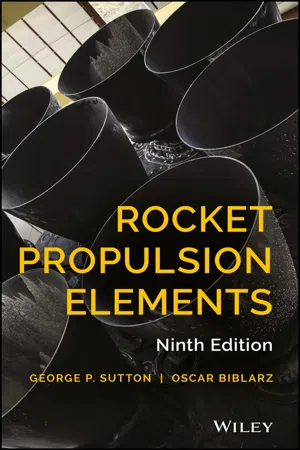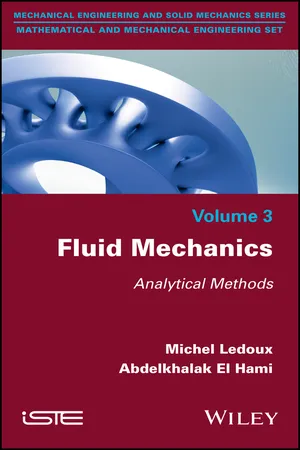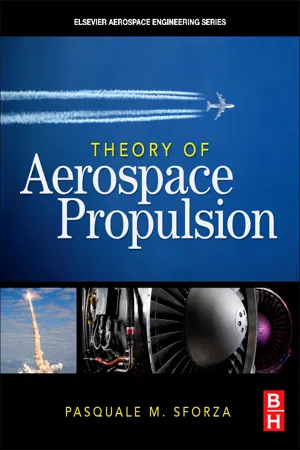Technology & Engineering
Jet Propulsion
Jet propulsion is a method of creating thrust by expelling a high-velocity jet of gas or fluid in the opposite direction of the desired movement. This principle is commonly used in aircraft and spacecraft propulsion systems. It relies on Newton's third law of motion, which states that for every action, there is an equal and opposite reaction.
Written by Perlego with AI-assistance
5 Key excerpts on "Jet Propulsion"
- eBook - ePub
- T. W. Lee, Peter Belobaba, Jonathan Cooper, Allan Seabridge(Authors)
- 2013(Publication Date)
- Wiley(Publisher)
1 Introduction to Propulsion Systems Propulsion systems include some of the most advanced technologies. The high performance requirements, at low system weight, necessitate advanced thermal-fluid design, materials and system integration. The thrust, generated through a simple-looking principle of conservation of momentum (or Newton's second law), enables many human capabilities, such as high-speed civil transport (approximately 12 hours for trans-Pacific flights), affordable personal aircraft, advanced military aircrafts (e.g. F-22 Raptor, Sukhoi), Earth orbital operations (Space Shuttle) and numerous satellites, planetary probes and possible missions. The propulsion technology can also lead to potentially destructive uses, as in cruise missiles, intercontinental ballistic missiles and many other weapons propelled at high speeds. A typical gas-engine shown in Figure 1.1 achieves the high exit momentum through a sequence of devices that include compressor, combustor, turbine and nozzle. The ambient air is ingested in gas-turbine engines. The compressor consists of a series of rotating blades, which aerodynamically is a set of airfoils using rotary motion to generate a pressure differential as the air traverses the blade elements. The air pressure is increased in the compressor, and sent into the combustor where the fuel is injected, mixed with the air, and burned. The air energy (enthalpy) increase is now used in the turbines to convert some of the thermal energy (enthalpy) into shaft power. This shaft power is used to power the compressor, by simply having a common axis between the turbine and the compressor in turbojet engines. However, in turbofan engines, the turbine power is used to run both the compressor and the fan. The fan adds enthalpy to the air stream in the fan section. The energy available at the end of the turbine section is converted to air kinetic energy in the nozzle - eBook - ePub
- George P. Sutton, Oscar Biblarz(Authors)
- 2016(Publication Date)
- Wiley(Publisher)
CHAPTER 1 CLASSIFICATION In general terms, propulsion is the act of changing the motion of a body with respect to an inertial reference frame. Propulsion systems provide forces that either move bodies initially at rest or change their velocity or that overcome retarding forces when bodies are propelled through a viscous medium. The word propulsion comes from the Latin propulsus, which is the past participle of the verb propellere, meaning “to drive away.” Jet Propulsion is a type of motion whereby a reaction force is imparted to a vehicle by the momentum of ejected matter. Rocket propulsion is a class of Jet Propulsion that produces thrust by ejecting matter, called the working fluid or propellant, stored entirely in the flying vehicle. Duct propulsion is another class of Jet Propulsion and it includes turbojets and ramjets; these engines are more commonly called air‐breathing engines. Duct propulsion devices mostly utilize their surrounding medium as the propellant, energized by its combustion with the vehicle's stored fuel. Combinations of rockets and duct propulsion devices have been attractive for some applications, and one is briefly described in this chapter. The energy source most commonly used in rocket propulsion is chemical combustion. Energy can also be supplied by solar radiation and by a nuclear reactor. Accordingly, the various propulsion devices in use can be divided into chemical propulsion, nuclear propulsion, and solar propulsion. Table 1–1 lists many important propulsion concepts according to their energy source and type of propellant. Radiant energy may originate from sources other than the sun and theoretically includes the transmission of energy by ground‐based microwaves and laser beams. Nuclear energy originates in transformations of mass within atomic nuclei and is generated by either fission or fusion. Energy sources are central to rocket performance and several kinds, both within and external to the vehicle, have been investigated - eBook - ePub
Fluid Mechanics
Analytical Methods
- Michel Ledoux, Abdelkhalak El Hami(Authors)
- 2017(Publication Date)
- Wiley-ISTE(Publisher)
S appears in the calculation.6.3. Thrust of a Jet Propulsion system, and propulsive efficiency
The expression of thrust is useful for the resolution of many of the problems presented here; as such, we shall make a generalizable presentation of it in the following examples.6.3.1. Calculation of the thrust of an “airplane engine”
Here we provide a general form of reasoning, resulting in a simple representation of the thrust and propulsive efficiency. In some of the textbooks, the presentation of the propulsive efficiency is not quite complete. This can mean that the relation between the initial energy provided and the energy consumed by the propulsion is provided, but no mention is made of where the “lost” energy goes. Here we shall fill this in.We shall need to use Euler’s first theorem by projection onto a unique axis, usually denoted by Ox.In a normal jet system (engine), the axis of the engine is enough for this projection. In our reasoning, we orientate Ox in the direction of the exiting matter.A distinction must be made between:- a) the quantity of matter going through the engine per unit of time;
- b) the velocity vectors of this matter as it enters or exits.
- eBook - ePub
Advanced Aircraft Design
Conceptual Design, Analysis and Optimization of Subsonic Civil Airplanes
- Egbert Torenbeek, Peter Belobaba, Jonathan Cooper, Roy Langton, Allan Seabridge(Authors)
- 2013(Publication Date)
- Wiley(Publisher)
The history of civil aviation has shown that a prominent contribution to improved energy efficiency and economics stems from advancements in propulsion technology [28]. Since the end of the Second World War, gas turbine engines have evolved significantly through coordinated development in airplane and engine technology. For instance, the Boeing 707 used the evolution from the turboprop to the turbojet engine to fly faster and higher whereas the need for more range led to the development of bypass engines around 1960. Larger engines with high bypass ratios were developed during the 1960s to meet the high take-off thrust and reduced fuel consumption requirements of wide body airliners. Since 1970, the continuous development of turbofans into more efficient and reliable engines has been gradual but significant. Within half a century, their thermal efficiency has increased from less than 0.40 for the straight jet engine to about 0.50 for the modern turbofan engine. The take-off thrust of the largest turbofans has increased from 20 to 45 tons, specific fuel consumption (SFC) decreased by approximately 30%; see Figure 2.7 (a). The greatest improvement came from the propulsive efficiency improving from about 0.50 to 0.75. Open rotor turbofans may improve this further to 0.90. A new generation of very high bypass ratio engines is emerging and the next step to open rotor technology may mature sooner than expected. The installation of these advanced engines may necessitate a marked change in the general arrangement of new airplanes.This chapter gives an overview of the terminology associated with gas turbine engine technology and performances, covering subjects specifically selected to be applicable to conceptual design and performance analysis. For this purpose, the most relevant properties are engine power and thrust, specific fuel consumption and engine efficiencies. Several generalized performance characteristics will be presented in non-dimensional form for use in cruise performance optimization and in engine scaling. Aircraft gas turbines operate on the Brayton cycle; however, cycle analysis is outwith the scope of this text. Several excellent textbooks on gas turbine engine cycles, performance analysis and technology are mentioned in the bibliography.3.2 Basic Concepts of Jet Propulsion 3.2.1 Turbojet ThrustThe thrust of a straight jet engine is derived from the momentum equation, using the control surface as indicated in Figure 3.1 . At flight speed V , ambient air with mass flow rate enters the inlet with momentum , referred to as ram drag (or inlet momentum drag). The compressed air is heated by the injection of fuel with the flow rate and then burning it at high pressure. The hot gas drives the turbine and exits the engine through the nozzle. Its total mass flow rate is , with f denoting the fuel/air mass ratio. Average properties in the nozzle exit with area A e are velocity v e and pressure p e determinoing the gross thrust,(3.1)where - eBook - ePub
- Pasquale M. Sforza(Author)
- 2011(Publication Date)
- Butterworth-Heinemann(Publisher)
Space propulsion systems are illustrated in terms of their specific impulse and specific mass. Electric propulsion systems are introduced, and their operation is characterized as electrothermal, electrostatic, or electromagnetic, depending on the mechanism by which they produce thrust. Electrothermal propulsion devices, including resistojets, arcjets, and radio-frequency or microwave excited jets, are shown to operate by heating a propellant and then accelerating the heated gas through a nozzle, just like chemical or nuclear rockets. Electrostatic propulsion devices do not require a physical nozzle to accelerate the propellant but instead employ an electric field to accelerate heavy positive ions to produce thrust, which is demonstrated by means of a one-dimensional analytical model. Ion engines and Hall effect thrusters, electrostatic rockets of high specific impulse currently used in space applications, are described. Electromagnetic propulsion devices that use electromagnetic forces arising from crossed electric current and magnetic fields, such as the magnetoplasmadynamic thruster and the pulsed plasma thruster, are discussed.14.1. Space Propulsion Systems
The thrust force for typical space propulsion reaction engines with constant exhaust velocity Ve is(14.1)where the quantity mpro is the constant propellant flow rate passing through the engine. The figure of merit for space propulsion systems is the specific impulse, which measures the total impulse delivered by the engine per unit weight of propellant consumed, as shown here:(14.2)where gE is the gravitational acceleration at the surface of the Earth; the units of Isp are therefore given in seconds. The power in the engine exhaust is given by(14.3)This power may also be written, in the units of kW, as follows:(14.4)The mass of the spacecraft powered by the engine may be written as(14.5)The subscripts pay, pro, eng, and str refer to the payload, propellant, engine system, and structure, respectively. In terms of mass fractions, Equation (14.5) may be written as(14.6)Typically it is assumed that the engine system mass is proportional to the power delivered to the engine unit so that(14.7)where the primary power of the engine system is P and η is the efficiency with which that power is transformed and delivered to the engine itself. Quantity α is the constant of proportionality and is called the specific mass of the power source; it has the units of kg/kW. It is the second figure of merit for the space propulsion system. The power in the exhaust stream is then given bywhere η′ is the efficiency with which the power in the engine is converted to power in the exhaust jet. The thrust to weight ratio of the engine is the third figure of merit and is related to Isp and α through Equations (14.2) , (14.4) and (14.7)
Index pages curate the most relevant extracts from our library of academic textbooks. They’ve been created using an in-house natural language model (NLM), each adding context and meaning to key research topics.
Explore more topic indexes
Explore more topic indexes
1 of 6
Explore more topic indexes
1 of 4




